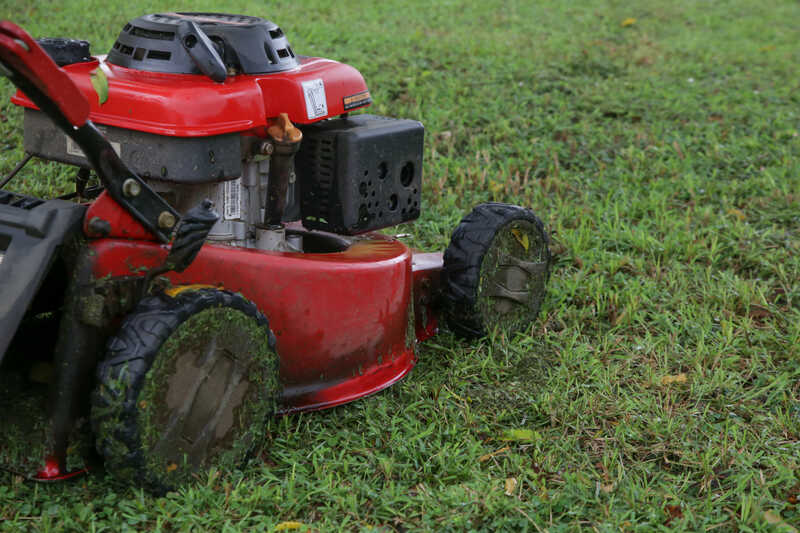
Although you can mow wet grass, we don’t recommend it, since mowing grass when it’s wet increases safety hazards and isn’t good for the health of your lawn.
But if you live in a wet area of the country where it rains nonstop for extended periods, eventually mowing a wet lawn becomes inevitable. Mowing slowly at a taller height, keeping your mower blades sharp, and using a silicone spray are just a few of the ways to mow wet grass without causing damage to your grass or mowing equipment.
Squeegee Water on Lawn with Garden Hose
When mowing wet grass is unavoidable, here are two ways you can use a garden hose to reduce the amount of moisture on your lawn.
Squeegee method: With a hose, you can reduce the amount of moisture sitting on your grass. This helps your grass dry faster. To remove morning dew or excess moisture from rain, drag a hose through your grass to knock off water droplets and let the soil soak up the excess water.
Siphon method: For puddles in your yard, siphon the water away from your lawn to help your grass dry out.
- Fill your garden hose with water. Turn off the nozzle.
- Place the hose fitting in a puddle. It must be completely submerged.
- Place the nozzle end of the hose near a drain where it can deposit the water. It must be lower than the water source so that the liquid can flow downwards. Then disconnect the nozzle.
- The hose will automatically siphon water out of your yard. Let it run until it is no longer able to siphon water.
If your yard is so drenched from recent rains that you are considering siphoning off the excess, consider letting the sun come out before you mow.
Although siphoning can help, “mowing [a wet lawn]—especially with heavy equipment—can result in depressions that alter (unfavorably) the uniformity of the surface. Under these circumstances, mowing should be delayed until the lawn dries and the surface becomes firm,” says Alfred Turgeon, former turfgrass management professor at Penn State College of Agricultural Sciences.
| If you don’t want to deal with mowing a wet lawn yourself, hire a LawnStarter pro to mow your yard for you. Our customers pay an average of $48 per mowing service. |
Keep Mower Blades Sharp
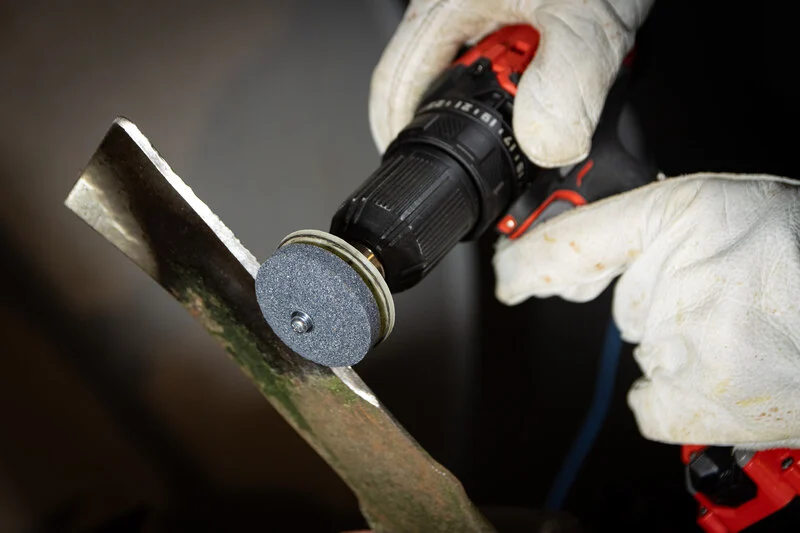
Dull mower blades tear grass instead of cutting it, and it is difficult for dull blades to cut through wet grass. To minimize the amount of strain on your lawn mower, sharpen your lawn mower blades before you mow.
See Related: How Often Should You Sharpen Lawn Mower Blades?
Raise Mower Height
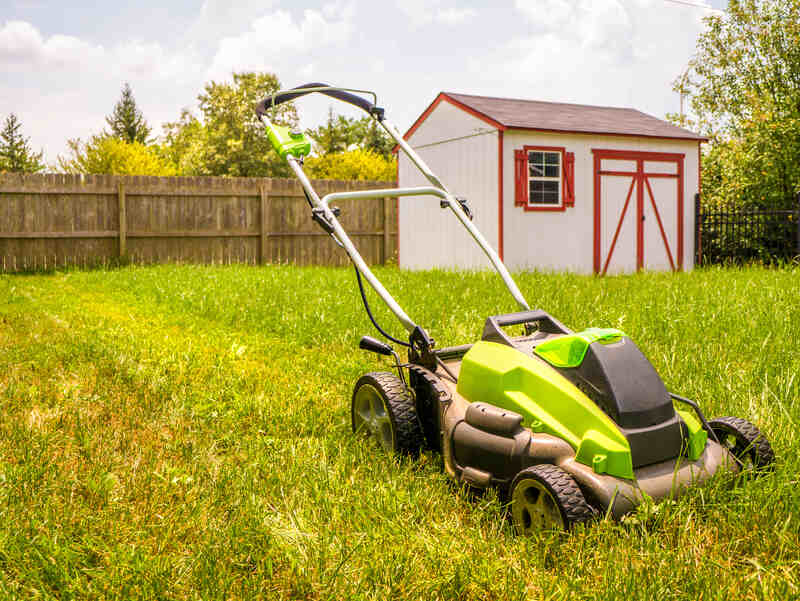
You’re more likely to get an even cut if you set your lawn mower a few notches above the normal cutting height. This usually means setting the mowing height to 4 inches or so.
When set at a higher setting, the lawn mower doesn’t have to work as hard. Since there is less grass to trim, you also reduce the likelihood of a clogged mower.
Apply Deck Spray
A silicone lubricant spray is a non-stick spray that prevents dirt and grass clippings from sticking to the underside of your lawn mower.
To reduce the chances of a clog, apply the non-stick spray to the mowing deck and discharge chute before mowing. To properly apply a deck spray:
- Disengage the power source (cord, spark plug, battery)
- Clean the mowing deck and blades before applying the spray.
- Allow the spray to dry before use.
Don’t Bag Clippings
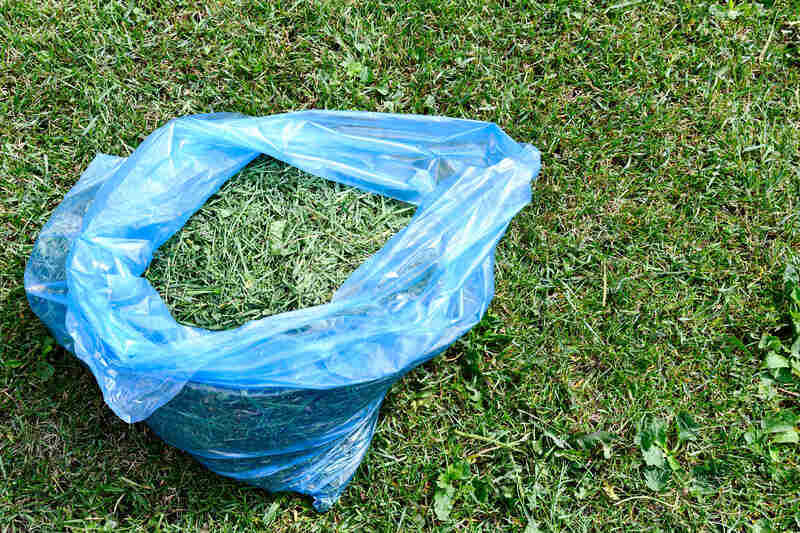
When the lawn is wet, bagging grass clippings increases the risk of a mower clog caused by damp grass. To make mowing wet grass easier, open the side discharge chute instead of bagging.
Here’s what happens when you don’t bag grass clippings on a wet lawn:
- It reduces strain on your lawn mower.
- It helps prevent clogs in your mower deck.
- It reduces the weight of heavy grass in your lawn mower, making your lawn mower lighter and easier to push.
- Grass clippings can become fertilizer that provides nutrients to your grass.
If you must bag the grass clippings, empty the bag frequently to lessen the strain on you and your lawn mower.
See Related: What is Grasscycling?
Mow Slowly
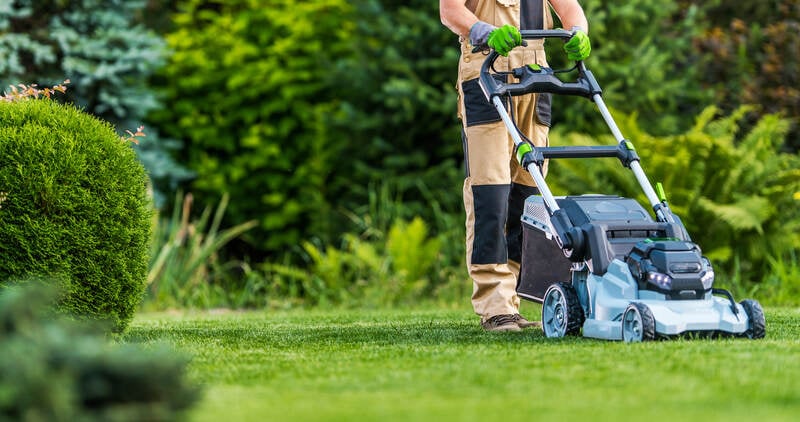
Your yard isn’t a race track. A rushed mowing job creates a jagged, uneven cut, even on a dry day. But wet grass is thick and requires more effort for the mower blades to cut evenly. To finish with an even trim, mow wet grass at a steady rate (about half your usual mowing speed).
Overlap Passes by 50%
Overlap passes by 50%. That means that half of each row should be mowed grass and the other half should be uncut grass. This allows your lawn mower to trim wet grass effectively, reducing the amount of strain on the lawn mower. Ultimately, when the job is done, you will have mowed each area of your lawn twice.
Mowing in half passes also breaks up clumps of grass clippings and spreads them out so they form an even layer over your yard.
Change Direction
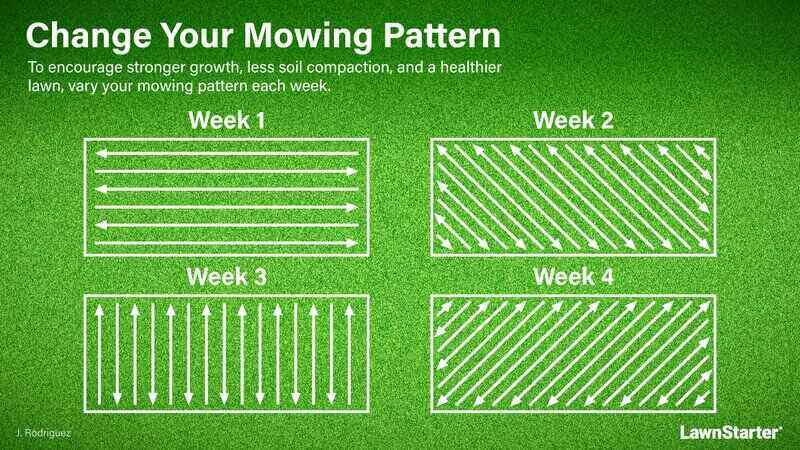
When you mow wet grass, change your mowing direction each time you mow. For one week, mow vertical rows. Then the next week, mow in horizontal rows. This preserves the aesthetic appeal of your lawn by preventing unevenly mowed grass.
Apply the One-Third Rule
The one-third rule for mowing dictates that you should never remove more than one-third of your grass blades during a single mowing session. It’s difficult for a lawn mower to smoothly cut wet grass, so don’t strain your lawn mower by cutting off more grass than you need to.
Clean Mower Thoroughly
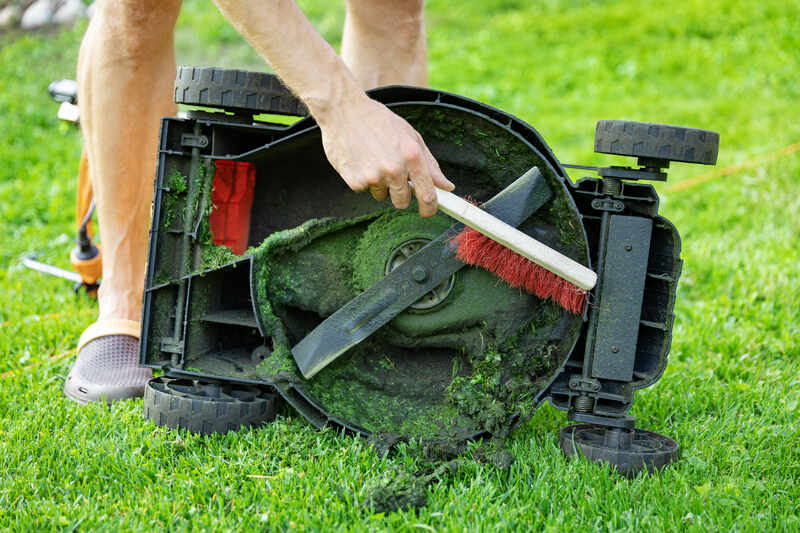
After you finish mowing, clean the mower deck and mower blades. Check that there aren’t damp grass clippings stuck in the mowing deck or clogging the filter.
Make it a habit to clean your lawn mower (especially the mowing deck) after each mowing, even after trimming dry grass.
My Tip: I keep a hand broom for cleaning my lawn mower stored in my shed next to my other mowing equipment. After every mow, I immediately brush the dust and dead grass off my lawn mower and clean the filter before I put the lawn mower away.
Dry Equipment
Mowing equipment should be dry when you start and finish, so dry your mower well after you clean it to avoid rust and corrosion. Let the blades run (if you use the deck port wash), use a rag, or hit it with a leaf blower to disperse any remaining water droplets. Once it’s dry, this is a good time to apply a deck spray (see tip above) to provide further protection.
FAQ About Mowing Wet Grass
Cutting wet grass can be hazardous, so here are some safety precautions to take:
• Don’t mow while it’s raining. Mowing in the rain can permanently damage a lawn mower engine.
• Don’t use electric-powered lawn mowers. Protect yourself from electrocution by not using electric mowers on a wet lawn.
• Wear sturdy footwear. Wear shoes with good traction and strong support to reduce the chances of slipping on wet grass.
• Avoid mowing hills. Wet grass is slippery and makes it easy to fall on a hill or an incline when the grass is wet. For a lawn that grows on a slope, wait until it dries to mow.
To avoid mowing, consider some alternative methods for cutting grass:
• Partial mowing: Separate your yard into different zones and mow each zone separately at a different time.
• Trimming: A string trimmer (aka weed whacker) is an alternative to traditional mowing, especially for small yards.
• Hand scything: “Another alternative is hand scything, a laborious method requiring some skill to achieve a uniform cut,” says Turgeon.
• Sheep: Turgeon also suggests using sheep to keep grass height down. “This was the dominant method prior to the invention of the lawn mower in 1830,” he says.
Lightweight, gas-powered lawn mowers with a side discharge are the best type of lawn mower for mowing wet grass. Avoid using mulching lawn mowers.
Safety Tip: Never use an electric lawn mower on wet grass. They are a safety hazard in wet areas, since the mixture of electricity and water increases the risk of electrocution.
Hire a Pro to Mow Your Lawn
When it’s impossible to wait for your grass to dry, you can reduce the strain on your lawn mower by following the one-third mowing rule, raising the height of your lawn mower, and not bagging. Mowing slowly and overlapping passes by 50% also helps alleviate the chore of mowing wet grass.
If your area has been experiencing a long rainy season with few breaks and you don’t have the time to mow it yourself, find a professional lawn care company in your area today.
Read More:
- When Not to Mow Your Lawn
- When is the Best Time to Mow My Lawn?
- How to Mow Your Lawn: A No-Nonsense Guide
- 13 Common Lawn Mowing Mistakes to Avoid
Sources:
- Al J. Turgeon. Professor emeritus of turfgrass management at Penn State College of Agricultural Sciences, University Park, PA. Personal interview.
- “How to Mow Now That it has Stopped Raining.” By Aaron Patton, turfgrass Extension specialist. Purdue University.
Main Image Credit: triocean / Adobe Stock